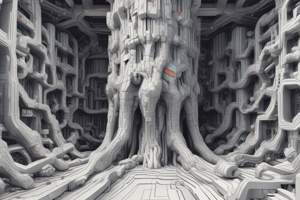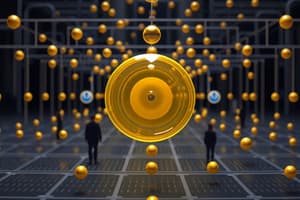Podcast
Questions and Answers
What is perceptual organization?
What is perceptual organization?
- The task of determining what edges and other stimuli go together to form an object (correct)
- A depth cue whereby closer objects block one's view of things farther away
- The ability to perceive distance
- An illusion in which lights or images flashed in rapid succession are perceived as moving
What is depth perception?
What is depth perception?
The ability to perceive distance.
What does interposition refer to in depth cues?
What does interposition refer to in depth cues?
A depth cue whereby closer objects block one's view of things farther away.
Define relative size in terms of depth perception.
Define relative size in terms of depth perception.
What is meant by height in the visual field?
What is meant by height in the visual field?
Explain linear perspective.
Explain linear perspective.
What does texture gradient imply?
What does texture gradient imply?
Define motion parallax.
Define motion parallax.
What is accommodation in terms of vision?
What is accommodation in terms of vision?
Explain convergence.
Explain convergence.
What does binocular disparity refer to?
What does binocular disparity refer to?
Define looming.
Define looming.
What is stroboscopic motion?
What is stroboscopic motion?
What does perceptual constancy mean?
What does perceptual constancy mean?
What is top-down processing?
What is top-down processing?
Define bottom-up processing.
Define bottom-up processing.
What are schemas?
What are schemas?
What is the parallel distributed processing (PDP) model?
What is the parallel distributed processing (PDP) model?
Define attention in psychology.
Define attention in psychology.
Flashcards are hidden until you start studying
Study Notes
Perceptual Processes
- Perceptual Organization: Determines which edges and stimuli combine to form identifiable objects.
- Depth Perception: Ability to perceive distances between objects, crucial for spatial awareness.
Depth Cues
- Interposition: Closer objects obstruct distant ones, providing depth information.
- Relative Size: Larger objects are perceived as closer than smaller ones, aiding in depth perception.
- Height in the Visual Field: Objects positioned higher appear more distant, contributing to depth perception.
- Linear Perspective: Objects near the convergence point of two lines are viewed as farther away.
- Texture Gradient: Finer textures indicate greater distance, as textures change gradually with distance.
- Motion Parallax: Differences in movement rate among objects indicate their relative distances.
Visual Mechanisms
- Accommodation: Lens adjustment to focus light rays for clear vision of varied objects.
- Convergence: Rotational movement of the eyes to focus on an object, providing depth information.
- Binocular Disparity: Variance between images on each retina serves as an essential depth cue.
Motion Perception
- Looming: Rapid enlargement of an object's image on the retina signals proximity.
- Stroboscopic Motion: Rapid sequence of images perceived as continuous motion creates motion illusions.
Perceptual Stability
- Perceptual Constancy: Objects are perceived as stable in size, shape, and color despite changes in sensory input.
Cognitive Processing
- Top-Down Processing: Recognition influenced by higher cognitive functions and prior expectations.
- Bottom-Up Processing: Recognition based on sensory data received first by the brain.
Mental Structures
- Schemas: Mental frameworks formed from experiences and expectations influencing perception.
- Parallel Distributed Processing (PDP) Model: Object recognition involves simultaneous analysis of various elements by interconnected neural units.
Attention
- Attention: A focus of mental resources that enhances perception, performance, and overall cognitive experience.
Studying That Suits You
Use AI to generate personalized quizzes and flashcards to suit your learning preferences.




